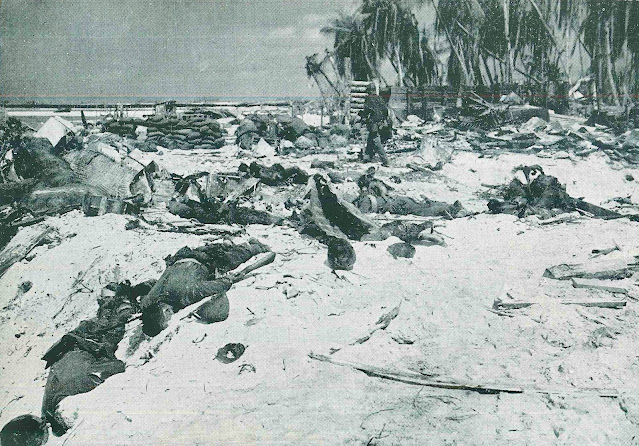Bullet fragments and the bodies of many dead Japanese soldiers litter the sandy beach after American forces captured Petio Island in the Tarawa Atoll in the Pacific Ocean during the Battle of Tarawa. The Battle of Tarawa saw American troops recapture territory occupied by the Japanese within the Gilbert Islands. A larger horde of American troops invaded, breaking out on November 20, 1943, with American forces first landing on Makin Island, more than 160 kilometers north of Tarawa Island. The Japanese defenses on Makin Island were weak and American losses were low.
Next, American forces landed on Betio Island within Tarawa Atoll. Firmly entrenched on Betio Island, the Japanese defenses fought for about 76 hours between November 20 and November 23, 1943, at the expense of the Battle of Tarawa. The Japanese garrison of some 4,690 men on Petio Island counterattacked stubbornly from behind the solid fortifications. The Americans exterminated the Japanese defensive positions one by one with aerial bombardment and artillery fire. The Americans defeated the last Japanese counterattack on the night of November 22-23, 1943. By the time the last Japanese defenses were eliminated, the Battle of Tarawa had claimed the lives of some 1,000 more American soldiers, wounded twice as many, and left some 400 American troops missing. The Japanese army was virtually wiped out in a ball. The American forces suffered heavy casualties in the Battle of Tarawa and were dubbed the "Terrible Tarawa" or "Tragic Tarawa.
Japanese forces suffered more than 3,000 deaths on Petio Island. An estimated 1,000 Korean workers were also killed. These bodies were buried where they fell or in blast craters and existing trenches. In many cases, the casualty figures are mixed with those of the Japanese and Korean forces. In the battle for Tarawa, only one Japanese officer, about 16 soldiers, and about 129 Korean workers out of a force of about 1,200 survived from a unit of 4,690 Japanese soldiers. American casualties were about 978 killed in action and about 2,188 wounded in action. in the Washington Post and the New York Times on December 4, 1943, the front page of the paper stated, "American soldiers, instead of praising the Japanese for capturing Tawala Atoll, found numerous dead bodies of both sides scattered everywhere. The article went on to say. The high number of American casualties immediately led to widespread and indiscriminate fighting among the American public, which also provoked anger against the American military.

